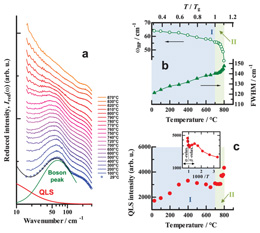Research Abstract
ガラスにおける構造緩和と準弾性光散乱:強誘電およびイオン伝導相によるアプローチ
Structural relaxation and quasi-elastic light scattering in glass: Approach by ferroelectric and ion-conducting phases
2012年10月8日 Scientific Reports 2 : 714 doi: 10.1038/srep00714

非弾性光散乱は、ガラスの構造やその緩和を調べるのに利用されている。しかし、準弾性光散乱(QLS)現象は、詳細に検討されたことがない。今回我々は、酸化ニオブ(Nb2O5)を多量に含むガラスにおいて、2つの温度領域、すなわち過冷却液体(SCL)状態(α-緩和領域)とガラス転移温度以下(β-緩和領域)で顕著なQLS強度の変動を観察した。これら変動は、強誘電相とイオン伝導相における概念に基づいて説明できる可能性がある。観察されたQLSは、NbO6ユニットの分極ゆらぎの結果生じたことが示唆され、α-領域においてはSCL相におけるナノメトリック相分離ダイナミクスによるもの、またβ-領域ではNbO6ユニット近傍に局在する伝導性イオンのマイグレーション/ホッピングによるゆらぎによるものと考えられる。
高橋 儀宏1, 中村 健作1, 長田 実2 & 藤原 巧1
- 東北大学 大学院工学研究科 応用物理学専攻 光物性学分野
- 独立行政法人 物質・材料研究機構 国際ナノアーキテクトニクス研究拠点
Inelastic light scattering has been utilized for examining the structure of glass and its relaxation. However, the quasi-elastic-light-scattering (QLS) phenomenon has not been addressed in much detail. In this study, we observed pronounced QLS-intensity variations in two temperature domains—supercooled liquid (SCL) state (α-relaxation regime) and below the glass-transition temperature (β-relaxation regime)—in niobium-oxide (Nb2O5)-rich glass. These variations may be interpreted on the basis of the concept of ferroelectric and ion-conducting phases. It was suggested that the observed QLS originates as a result of the polarization fluctuation of NbO6 units, which is due to the dynamics of the nanometric phase separation in the SCL phase (α-regime), and the fluctuation due to the migration/hopping of conductible ions that are localized in the vicinity of the NbO6 units (β-regime).

